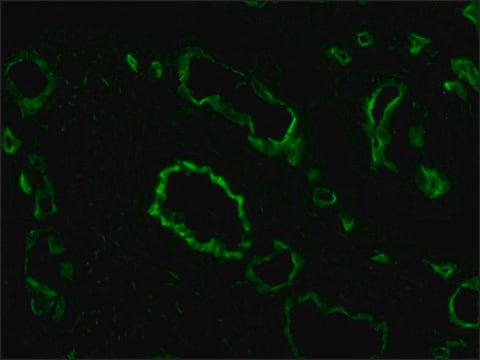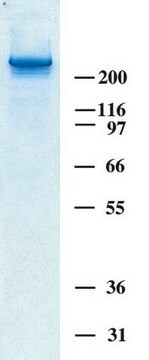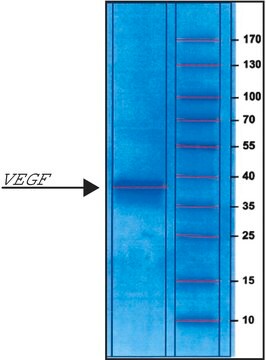추천 제품
생물학적 소스
human
Quality Level
재조합
expressed in HEK 293 cells
무균
sterile
분석
≥95% (SDS-PAGE)
양식
lyophilized powder
분자량
127.5 kDa (The protein migrates as a 140 kDa band on SDS-PAGE due to glycosylation.)
포장
pkg of 50 μg
기술
cell culture | mammalian: suitable
불순물
≤1 EU/μg endotoxin, tested
solubility
water: soluble
NCBI 수납 번호
UniProt 수납 번호
배송 상태
dry ice
저장 온도
−20°C
유전자 정보
human ... THBS1(7057)
일반 설명
Thrombospondin-1 (TSP1) belongs to family of glycoproteins and possesses a complex trimeric structure. The structure comprises a heparin-binding domain and a procollagen homology domain located at the amino terminus, while the carboxyl-terminal end contains type I, II, and III repeats. This protein is manufactured in human cells using an all-human production system, with no serum. The human cells expression system allows human-like glycosylation and folding, and often supports better stability of the protein in culture. Recombinant human thrombospondin-1 is expressed in HEK293 cells as a glycoprotein with a calculated moleculaer mass of 127.5 kDa.
애플리케이션
Thrombospondin 1 human (TSP1) has been used:
- To treat hepatocyte (IHH) cancer cells to study the role of aspartyl protease 1 (MfSAP1) in extracellular matrix degradation.
- In in vitro Extracellular Matrix (ECM) protein degradation assays.
- In rat C6 astroglioma cells, for coating the cell culture plates to study the effects of integrins on CNTF (ciliary neurotrophic factor) expression.
- In the preparation of secreted factor cocktail for analysis of the human mesenchymal stem cell secretome.
Recommended for use as a cell culture substratum at 1-5 μg/cm2 or 0.1-25 μg/ml. Optimal concentration depends on cell type as well as the application or research objectives.
생화학적/생리학적 작용
Thrombospondin (TSP1) plays a crucial role in guiding extracellular matrix (ECM) synthesis and facilitating dynamic tissue remodeling. It is involved in various biological processes including angiogenesis, matrix assembly, activation of transforming growth factor (TGF), and promotion of neurite outgrowth. TSP1 binds to various cell surface receptors, such as integrins and integrin-associated protein CD47. Studies have also shown that the signaling pathway involving TSP1-CD47 promotes the generation of reactive oxygen species (ROS) in human pulmonary artery endothelial cells. This signaling pathway plays a significant role in the manifestation of sickle cell-associated vasculopathy and the subsequent progression of pulmonary hypertension. Moreover, hypoxia-inducible factor (HIF)-2α has been shown to upregulate the expression of TSP1 under hypoxic conditions. TSP1 also plays a crucial role in inflammatory processes and post-inflammatory tissue dynamics. It is upregulated in rheumatoid synovial tissues and might be associated with rheumatoid arthritis.
특징 및 장점
- Human-derived thrombospondin
- Produced through recombinant expression in HEK 293 cells
- Low endotoxin levels
물리적 형태
Supplied as a powder, lyophilized from phosphate buffered saline.
분석 메모
The biological activity of recombinant human thrombospondin-1 was tested in culture by measuring the ability of immobilized DTT-treated thrombospondin-1 to support adhesion of SVEC4-10 cells.
Storage Class Code
11 - Combustible Solids
WGK
WGK 2
Flash Point (°F)
Not applicable
Flash Point (°C)
Not applicable
Gesine M Dittrich et al.
Basic research in cardiology, 116(1), 26-26 (2021-04-21)
Heart failure due to high blood pressure or ischemic injury remains a major problem for millions of patients worldwide. Despite enormous advances in deciphering the molecular mechanisms underlying heart failure progression, the cell-type specific adaptations and especially intercellular signaling remain
Si En Poh et al.
Frontiers in cellular and infection microbiology, 10, 148-148 (2020-04-25)
Malassezia is the most abundant eukaryotic microbial genus on human skin. Similar to many human-residing fungi, Malassezia has high metabolic potential and secretes a plethora of hydrolytic enzymes that can potentially modify and structure the external skin environment. Here we
Samira Ghorbani et al.
Nature communications, 13(1), 2445-2445 (2022-05-05)
Remyelination failure in multiple sclerosis (MS) contributes to progression of disability. The deficient repair results from neuroinflammation and deposition of inhibitors including chondroitin sulfate proteoglycans (CSPGs). Which CSPG member is repair-inhibitory or alters local inflammation to exacerbate injury is unknown.
문서
Attachment Factors for 3-Dimensional Cell Culture
The extracellular matrix (ECM) is secreted by cells and surrounds them in tissues.
자사의 과학자팀은 생명 과학, 재료 과학, 화학 합성, 크로마토그래피, 분석 및 기타 많은 영역을 포함한 모든 과학 분야에 경험이 있습니다..
고객지원팀으로 연락바랍니다.







